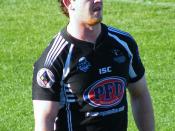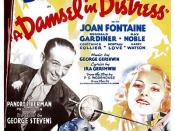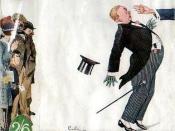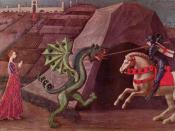'A frequent representation of women in literature is the role of the damsel in distress' Respond to this statement by referring to the character of the landlady in the short story of the same name.
Women are often portrayed as a damsel in distress in literature. This stereotype affects our reading of Roald Dahl's short story, The Landlady, and the reaction we have with its title character. Style, point of view and setting as well as characterisation amalgamate in The Landlady to support this bias.
The text introduces the Landlady as a woman of about forty-five to fifty years, with blue eyes and a round pink face. This description is amicable and shows good feeling on Billy's part towards the Landlady. Billy's sees her as "â¦exactly like the mother of one's best school-friendâ¦" (pg. 5). This shows that Billy sees her as no threat and trusts her fully, as she fits in with the stereotype of a kindly older woman in need of company.
He thinks that she is lonely and "slightly dotty." Though this is not particularly harsh, it shows that he believes the Landlady is a damsel in distress and therefore treats her as such.
A Bed and Breakfast in Bath is the home of the Landlady, and as it is her own domain, she is very much in control. Her accommodation is depicted in explicit detail, and shows that she is very proud of her home and is comfortable in her surroundings. She owns many luxuries, a bright fire, pleasant furniture, piano, animals and plants. Although we see that the Landlady has the upper hand, we do not believe she has any ill wish, as her home is so accommodating and her manner so friendly. We disregard the clues before us, as the stereotyped view of her as a damsel in distress is so firmly lodged in our minds.
Third person limited point of view is used in the Landlady. This tells us the story from Billy's perspective and is consequently highly biased. He sees the Landlady as fragile, dotty and harmless, "â¦no question about that." (pg. 7). He sees her quirks and mannerisms as symptoms of her being a damsel in distress, needing his help to relieve her loneliness, not once thinking of the lengths she might go in order to gain his companionship. Billy thinks the Landlady is a damsel in distress as he makes an extra effort to be courteous and polite to her, wanting to help in anyway he can. The use of this point of view shows just how naive Billy is, and that he really does believe the Landlady to be a damsel in distress.
The Landlady's dialogue puts us into a position which encourages our view of her as a damsel in distress. Her words are very soft and kind and there is no sense of hurry or menace in them. According to Billy, she is "terribly nice" and a "kind and generous soul". (pg. 7). He thinks of her as placid and passive, and since the text is in third person limited, we quickly assume this to be the case. Portraying her in this way persuades the reader that she is a damsel in distress and unable to protect or care for herself. That behind this gentle persona is a potential murderer is unthinkable as we are unable to shake the tag of damsel in distress.
Throughout the text, the Landlady is referred to only as such. We are never told her name and this ambiguity creates the impression that she is a damsel in distress, a far-of being in need of rescue. The Landlady is repetitively and continuously referred to only as the landlady. She isn't ascribed as anything else, which distances her from Billy and makes her seem less real. Her anonymity makes her seem like a damsel in distress as we are familiar with this character type to be this way. This word use not only distances her from Billy but strengthens the readers subconscious view of her a damsel in distress.
The use of stylistic devices in the Landlady convince the reader that the title character is a damsel in distress, despite the obvious fact she is not. After reading the text, it still seems as unbelievable that she is a murderer as it would at the start. This is because we have grown so accustomed to women filling in the role of damsel in distress that even with Billy in this role; we cannot change our view of the Landlady. Getting overly familiar with a character role that it affects our entire reading practices is sadly common, with people reluctant to change their stereotyped views, despite it being clear they should.
Dahl, Roald 1959. 'The Landlady' first published in Collier's magazine.






